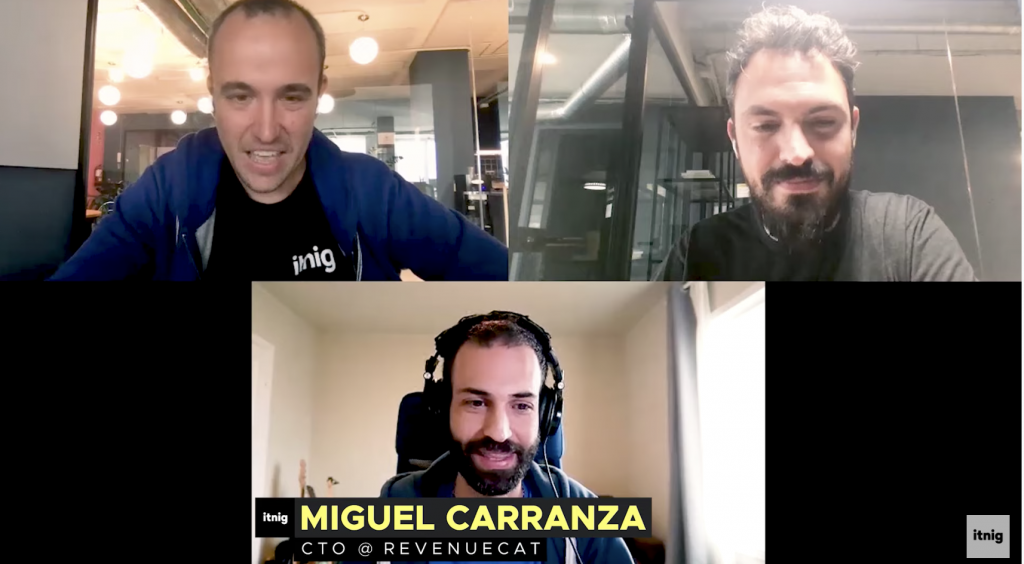RevenueCat, a San Francisco-based startup, is a simple API that allows developers to analyze and manage their app subscriptions on both iOS and Android devices. They have raised more than 16 million euros, have gone through YCombinator and have been invested by people like Jason Lemkin.

Miguel Carranza, co-founder, and CTO of RevenueCat explains the story and evolution of the company, and how it came to be considered a success case in Silicon Valley.
Why did you start RevenueCat?
RevenueCat exists because it was a need that we had ourselves. Both Jacob (CEO) and I used to work at a company called Elevate, which was the app of the year in 2014. When we launched Elevate, one of the problems we had was that the app was onetime-purchase.
At that time, SaaS was becoming a thing. We started paying attention to the issue of subscriptions. We realized that it was complex, because especially we, who were on Android and iOS, had a fairly new engineering approach. Apple’s system does not communicate with Google. If you buy on your Android phone but you have an iPad, you want to have your subscription also on your iPad. So we ended up assembling that and little by little it got bigger and there came a time when the product was very established. The changes we made to the product did not really affect retention that much and the monetization issue had to be optimized. So the tools weren’t enough.
We wanted to be able to sell outside of the AppStore because Apple and Google take 30 percent, so we wanted to avoid that fee. Jacob, who was the CTO at the time, wanted to start a company. We realized that this was really a necessity, that subscriptions were much more mainstream on AppStore, and that anyone wanting to build this was going to have to put in considerable engineering effort. Which was something that not many people are willing to learn and do.
So, you wanted to solve the problem by not having to touch the Android and Apple platforms?
Exactly. That was the value proposition at the beginning. The idea is that, on top of that, being a centralized point, you can sell from another site. If you have Stripe and you sell from your website, we will be the entity that says if someone has subscribed or not, or what product they have, or if they have a payment error or whatever. At first, most of our clients were freelance developers, but companies need tools to handle underwriting, which can be exponentially complex. Before Strip billing existed, you had to set up the recurrence and so on. But even if you use Stripe, you always have to build things on top of it.
There is a lot of business model that you simply cannot have in the AppStore because it is so complex. But there are people who do very sophisticated things with our APIs.
What’s RevenueCat’s target client?
Our target is the developer, we are Developer First. As a mobile application developer, I have suffered many SDKs that are Marketing First and have a series of tests. Developers end up hating the SDK that’s poorly implemented. So our target is originally the developer. We are building new tools on top that help people in finance, marketing, etc., but we are developers first.
Indeed, both of you (cofounders) are developers, right?
Yes. That is an interesting controversy. Many Spanish entrepreneurs have asked “how come there is no one with a business background? That is impossible.” Well, I instead ask “how can you set up a company without a technical founder?” That is another issue.
How many clients does RevenueCat have today?
It depends. It is difficult to say because being an SDK you never know when it integrates, when it has launched, maybe there are people who stay there in the middle, or it takes much longer to launch. We have more than 3000 applications launched. It means that they are in the AppStore and that at least someone has bought something. If you charge less than 10 thousand dollars it is totally free. Each plan has a base fee, one at $119, and the other at $499. And there’s also a fee that decreases as you have volume, a percentage with respect to the subscriptions you have. The basic one is 7 dollars for every thousand dollars you make. A client can have many installations, many apps.
How does RevenueCat attract customers?
It could be organic. We did events, and we’ve created educational content so that people can see how complex it is to manage subscriptions. Most have been content, written by the CEO.
Is Silicon Valley really the best place for entrepreneurship?
In my opinion, it is very overrated. People think that everyone is better here, which is not entirely true. Here are many people who are good, which doesn’t mean they’re better. Obviously an education at Stanford or M.I.T. is uncomparable. What you do see here is more ambition, so that helps you build your own ambition.
YCombinator tells you how to make a billion-dollar company. In Spain, they think about how to sell the company, they don’t think about going public.
Especially in terms of the product, maybe you are not the best engineer in the world, but you see that Google has done it and you say “well if Google has done it, I can do it too.” I think there is much more conformism in Spain. And in Spain, you can also create a great project, get talent, and get investment. There’s no excuse, just ambition differences.
What’s so special about YCombinator?
YC is THE accelerator. You can talk to any investor and they will tell you that when someone goes to a YCombinator demo-day, they mean that they are going to invest in something. They have the mentality of “I’m going to invest in something” when a normal investor thinks about the reason for not investing. Jacob wanted YCombinator because he was the first employee of a YCombinator company and he saw what that meant for the company. And well, I was also excited. I’ve been reading Hacker news and Paul Graham’s essays for a lifetime. I think it exceeds expectations, at least for us it was.
People say 7 percent is very expensive. It depends on the case, for us, we really had little revenue, 7 percent, for the change of that they gave us a very interesting assessment, with a product that practically was in beta. It’s a bit of a change of mind. I was in Silicon Valley, but I still hadn’t considered being able to build something so big. And when you go and you are in contact with the founders of Stripe or Airbnb and they tell you that they were about to die a lot of times, what they did wrong and how they did it, you see that they are normal people. And it takes away the imposter syndrome a bit too.
It’s also the pressure also knowing that you are surrounded by very good people, you know that you have a goal that you have to present to investors and you don’t want to be the dumbest in the room. I am sure that without that pressure we would not have reached the goals we had set so quickly. We set ourselves to make 250 thousand dollars in revenue from our clients. And we surpassed it and we reached 350 something.
That mentality changes you and then there is the network which is brutal, obviously. We spoke to Paul Graham, actually. He was on vacation, we had a 10-minute meeting with him and it was brutal because he helped us a bit with the presentation for the demo-day and he told us “the only thing I don’t like is the name. The name sounds like a toy. ” We didn’t change it, because it’s easy to remember and to pronounce and does not make any sense. But hey, Twitter didn’t make any sense either.
How did you meet Jason Lemkin?
He was the first investor. I think it was just when we announced RevenueCat on ProductHunt, he followed us on Twitter. And then we spoke with him by private message, we didn’t even have a deck ready, but there was mutual interest. Being in YCombinator also opens many doors for you when it comes to raising money, it is easier to close a funding round if investors know that you are or have been in YCombinator.
What are you planning on doing with the money you’ve raised?
It took us by surprise. We have always been super capital-efficient. The biggest cost we have, obviously, is salaries. In fact, we pay the same, regardless of where the employee is from anywhere in the world. We have never been to a big office, we’d rather spend it on people’s salaries.
I think the important thing is that we’ve seen how hyper-growth, if not done smartly, can destroy a company’s culture or you can end up hiring faster than you should. I think your company’s culture is an important thing and going from 2 to 5 is not that complicated, but when you go from 5 to 10 and then from 10 to 20, making sure the Cultural Fit is still there is complicated.
Our goal is to create a company that lasts a long time. Our mission is to help developers earn more money and make a living doing what they like. We could honestly have raised the round earlier. In fact, one of the things I think is “did we really need a 1.5 million seed-round?” We could have raise less. Also, it’s not convenient for you to have a huge valuation if afterward you don’t get to it.
We want to operate in such a way that, if we stop hiring, we are profitable. That is the way we have operated. The market can change. The best time to raise money is when you don’t need it.
For more interviews about startups, business, and technology, visit our channel or subscribe to the newsletter.
This post is also available in: Español (Spanish)
